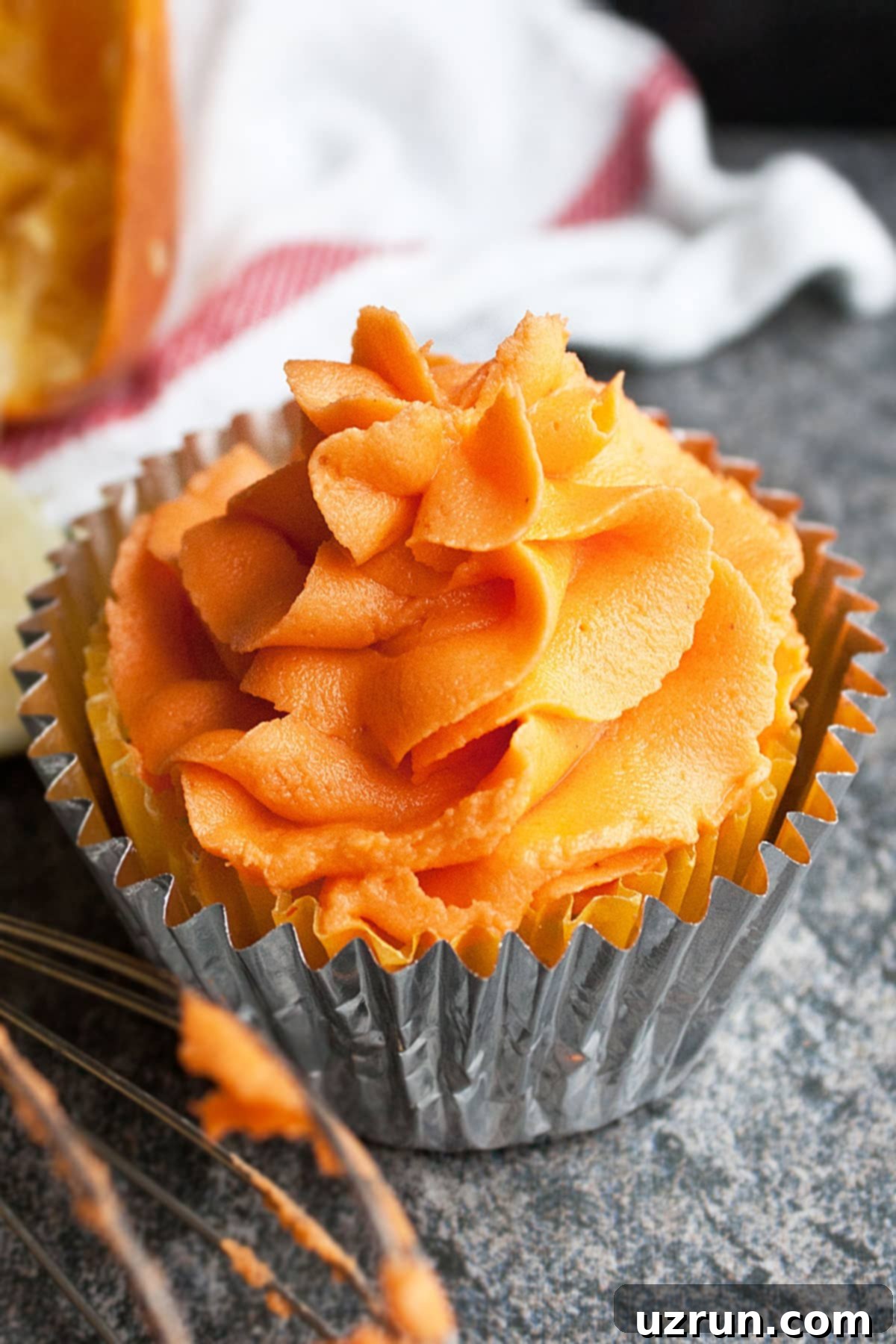Deliciously Easy Homemade Orange Frosting: Your Go-To Buttercream Icing Recipe
Get ready to brighten up your baking with this incredible, homemade orange frosting recipe! Whether you call it orange buttercream icing or dreamy creamsicle frosting, this recipe is quick, easy, and made with simple ingredients you likely have on hand. It whips up into a fluffy, creamy delight that’s not only perfect for elegant piping but also holds its shape beautifully, even on warmer days. We’ll also explore a delightful variation using cream cheese, ensuring there’s an orange-infused option for every preference and occasion.
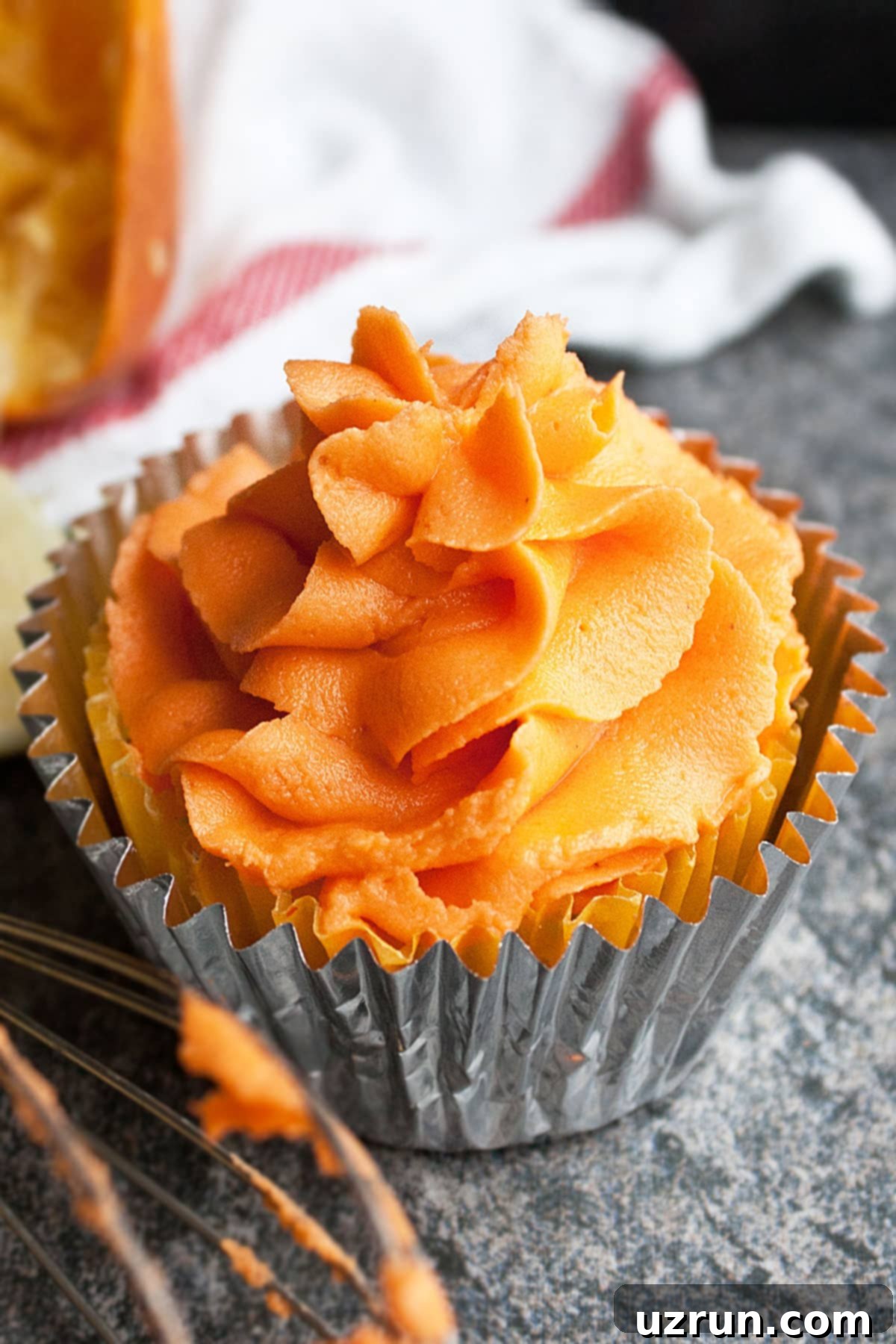
While this vibrant citrus frosting is a natural fit for bright Lemon Frosting (Buttercream Icing) and Lemon Curd (4 Ingredients) inspired summer desserts, its cheerful hue makes it an unexpected favorite for Halloween treats! Imagine vibrant orange swirls topping your spooky delights. This frosting boasts a naturally pale orange color, but I always recommend adding a touch of orange gel coloring to achieve that truly striking, vibrant shade that makes desserts pop. The intensely strong citrus flavor comes from a powerful trio of ingredients: fresh orange zest, a dash of orange extract, and a splash of freshly squeezed orange juice. This combination ensures every bite is bursting with authentic orange taste, making it an undeniable crowd-pleaser.
Why This Orange Frosting Is a Must-Try
Beyond its delicious flavor, this homemade orange buttercream stands out for several reasons. It’s incredibly versatile, acting as the perfect complement to a wide array of baked goods. Its smooth, creamy texture ensures it’s easy to spread, yet it’s firm enough to hold intricate piped designs, making it ideal for both novice and experienced decorators. The robust orange flavor is not artificial; it’s a genuine, zesty brightness that elevates any dessert. Plus, making it from scratch means you control the ingredients, ensuring a fresh, high-quality frosting every time.
Key Ingredients for Perfect Orange Buttercream
Crafting the perfect orange buttercream starts with selecting the right components. Each ingredient plays a crucial role in achieving that ideal balance of flavor, texture, and stability. Here’s a breakdown of what you’ll need and why:
- Unsalted Butter: Always use unsalted butter at room temperature. This ensures smooth, lump-free mixing and allows you to control the overall saltiness of your frosting. Butter contributes significantly to the rich flavor and creamy mouthfeel.
- Shortening: This ingredient is key for stability, especially if you’re baking in a warm environment or need the frosting to hold its shape for an extended period. Shortening helps prevent the buttercream from melting and losing its structure, making it perfect for piping elaborate decorations.
- Orange Zest: Don’t skip this! Fresh orange zest provides a concentrated burst of essential orange oils, delivering an incredible natural citrus flavor and a subtle hint of color that extract alone cannot replicate.
- Orange Extract or Emulsion: While orange zest provides natural flavor, orange extract or emulsion amplifies it, ensuring a robust and unmistakable orange taste. Emulsion oils are often stronger and can provide a more intense flavor without adding extra liquid.
- Powdered Sugar (Confectioners’ Sugar): This fine sugar is essential for a smooth, velvety frosting. Sifting it beforehand is highly recommended to prevent any lumps, which can ruin the texture of your finished buttercream.
- Fresh Orange Juice: Freshly squeezed orange juice is best for the most vibrant and authentic flavor. It not only adds a lovely citrus note but also helps to achieve the desired consistency, thinning out the frosting as needed.
- Orange Gel Coloring (Optional but Recommended): For a truly striking and vibrant orange hue, gel food coloring is your best friend. Unlike liquid food coloring, gel colors are highly concentrated and won’t thin out your frosting, allowing you to achieve a rich color without altering the consistency.
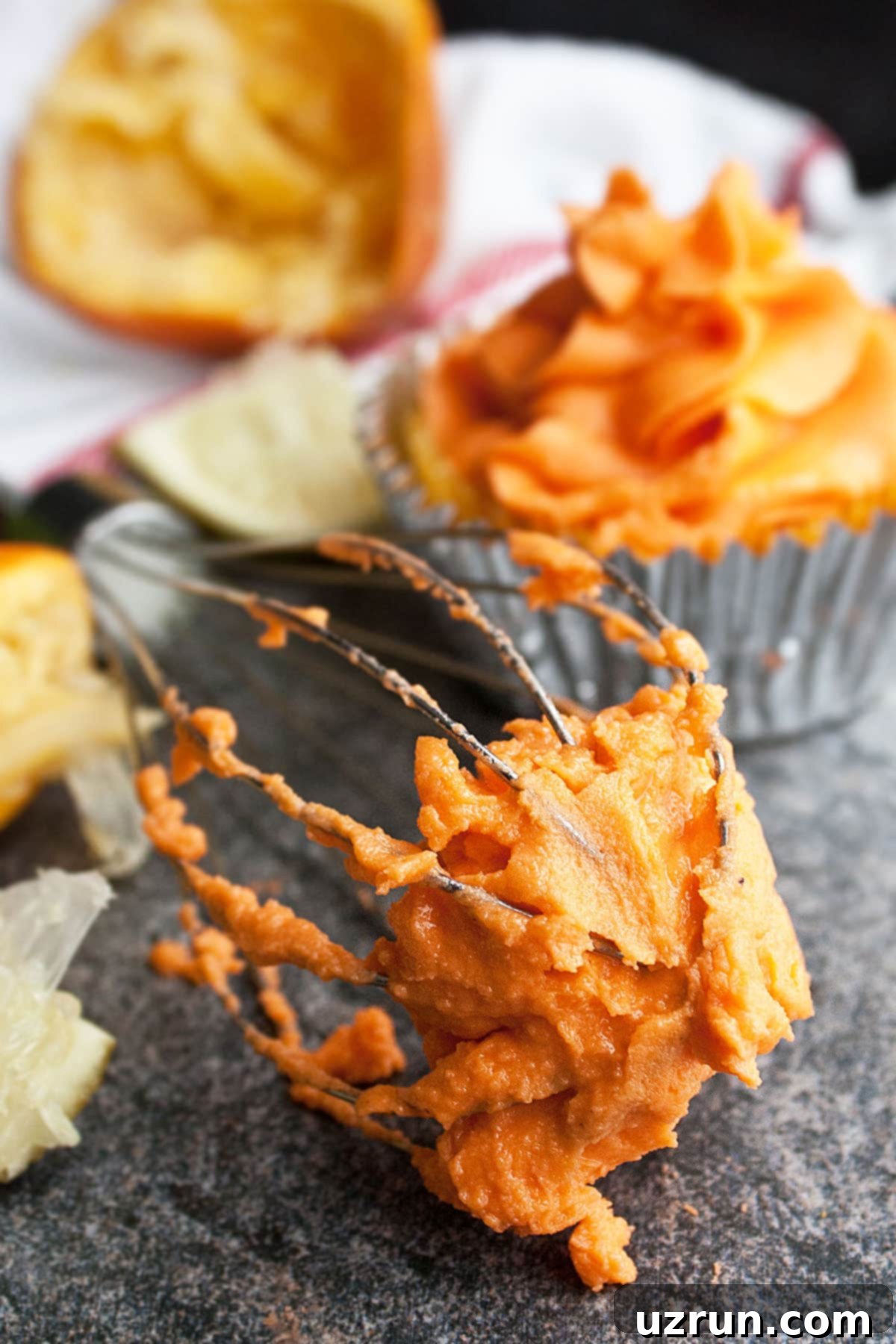
Creative Variations on Orange Frosting
This easy orange buttercream recipe serves as a fantastic foundation for countless delicious variations. Don’t be afraid to experiment and customize it to suit your taste or specific dessert needs. Here are some popular ideas to get you started:
- Whipped Cream Version: For a lighter, airier orange delight, prepare a batch of Homemade Stabilized Whipped Cream. Once it’s whipped to perfection, gently fold in some orange zest and a touch of orange extract. This creates a delicate and refreshing topping that’s perfect for fruit tarts or lighter cakes.
- Orange Glaze for Drizzling: If you’re looking for a thinner, pourable consistency, a simple orange glaze is ideal. Make a classic Powdered Sugar Glaze (Cake Glaze) or even a Lemon Glaze (Lemon Drizzle Icing). The key is to replace any vanilla extract with orange extract and incorporate freshly grated orange zest for that bright citrus punch. This is excellent for Bundt cakes, muffins, or scones.
- Decadent Chocolate Orange Version: For a truly indulgent treat, transform this into a chocolate orange frosting. Simply add ½ cup to ¾ cup of good quality unsweetened cocoa powder to the buttercream. You’ll likely need to add a bit more orange juice or water, a tablespoon at a time, to achieve your desired spreadable consistency. The combination of rich chocolate and zesty orange is a classic for a reason!
- Tangy Lemon Orange Flavor: Can’t decide between lemon and orange? Enjoy both! Replace ¼ cup of the orange juice with a blend of ¼ cup orange and lemon juice. Similarly, substitute 2 tablespoons of orange zest with 1 tablespoon orange zest and 1 tablespoon lemon zest. This creates a beautifully balanced, bright, and tangy citrus frosting.
- Delightful Vegan Icing: For a plant-based option, simply replace the dairy butter with a high-quality vegan shortening or a good brand of vegan butter. Ensure all other ingredients are also vegan-friendly (e.g., check powdered sugar for bone char if strict).
- Rich Cream Cheese Version: If you adore the tangy richness of cream cheese, you can adapt this recipe. Omit the shortening entirely and incorporate 4 ounces of softened cream cheese along with the butter. You may need to add some additional powdered sugar to achieve a pipeable consistency, as cream cheese can make frostings softer. However, be mindful that the cream cheese flavor can sometimes mellow the delicate orange notes, and it tends to be less stable in warm environments compared to a pure buttercream.
Cream Cheese Frosting vs. Buttercream Icing: A Detailed Comparison
While both cream cheese frosting and buttercream icing are incredibly popular and delicious, they offer distinct profiles and characteristics. Understanding these differences is crucial when deciding which one is best suited for your specific baking project, especially when incorporating delicate flavors like orange.
The primary distinction, as the names suggest, lies in their core ingredients. Buttercream icing is traditionally made with butter (and often shortening for stability, as in this recipe) as its primary fat, combined with powdered sugar, liquid (like milk or juice), and flavorings. It’s known for its incredibly smooth, rich, and velvety texture, making it excellent for piping intricate designs that hold their shape. The flavor of buttercream is typically neutral or subtly buttery, allowing added flavors like orange to truly shine and take center stage.
On the other hand, cream cheese frosting features cream cheese as a key ingredient, alongside butter, powdered sugar, and flavorings. The addition of cream cheese introduces a characteristic tangy note, which many people adore. While delicious, there are two main considerations when choosing a cream cheese version, particularly with a flavor like orange:
- Flavor Dominance: The distinct tang of cream cheese can often overpower more delicate citrus notes. If your goal is a vibrant, unmistakable orange flavor, the subtle cream cheese tang might compete with or even mask the bright orange zest and extract. For this reason, a pure orange buttercream often delivers a more pronounced orange experience.
- Stability Challenges: Cream cheese is not as stable as butter or shortening, especially in warmer temperatures. This means cream cheese frosting can be more challenging to pipe, as it tends to soften and lose its shape and peaks more easily. If you’re decorating elaborate cakes, planning outdoor events, or living in a warm climate, an all-butter and shortening buttercream will offer superior stability and peace of mind.
Both are undoubtedly delicious, but for a truly stable, pipeable, and intensely orange-flavored frosting, a traditional buttercream often emerges as the preferred choice. The cream cheese version, while delightful, offers a different textural and flavor experience that leans more towards a creamy, tangy profile.
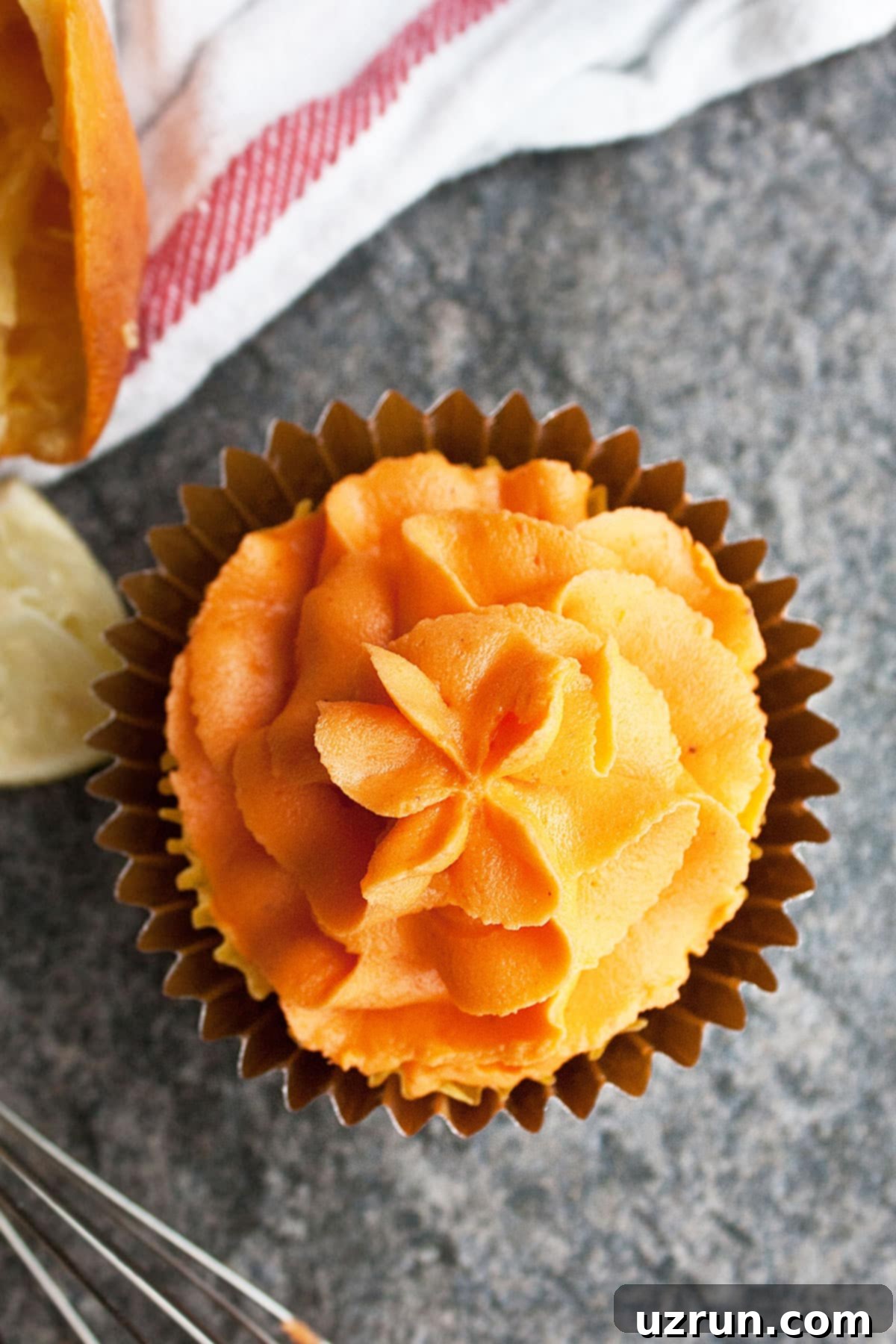
How to Use This Delicious Orange Frosting? Endless Possibilities!
The versatility of this easy orange frosting knows no bounds! Its bright flavor and lovely texture make it a perfect companion for a vast array of baked goods. Here are some of our favorite ways to incorporate this delightful orange buttercream:
- Elevate Your Cakes: Use it as a luscious topping or a flavorful filling for a variety of cakes. It pairs exceptionally well with classic Carrot Cake, light and airy Angel Food Cake, any Orange Cake, and surprisingly, even rich Chocolate Cake, where the orange provides a wonderful counterpoint to the deep cocoa.
- Perfect for Cupcakes: Create stunning swirls with a piping bag and tip, or simply spread a generous layer with a spatula on top of your favorite cupcakes. It’s fantastic on Best Vanilla Cupcakes, Vegan Chocolate Cupcakes, vibrant Yellow Cupcakes, indulgent Best Chocolate Cupcakes, or a natural pairing with Easy Orange Cupcakes.
- Enhance Buns, Rolls, and Biscuits: Take breakfast and brunch to a new level by spreading a generous layer of this orange buttercream on warm treats. It’s heavenly on Easy Homemade Cinnamon Rolls, Bisquick mix biscuits (like those in this Easy Strawberry Shortcake, offering an unexpected citrus twist), or even drizzled over Pecan Sticky Buns for an extra layer of sweetness and zest.
- Dress Up Muffins: While muffins aren’t typically frosted, a thin layer of this orange icing can transform them into a decadent dessert. Try it on Cranberry Orange Muffins for an intensified flavor, Chocolate Chip Muffins, or Chocolate Muffins for a wonderful citrus contrast.
- Decorate Your Cookies: This buttercream is fantastic for decorating or filling cookies. Pipe it onto Sugar Cookies (Small Batch), Easy Cut Out Sugar Cookies (With Cake Mix), or even spread it on Soft and Chewy Sugar Cookies for a delightful orange cream sandwich.
- Top Bars and Brownies: A thin, zesty layer of orange frosting can take your favorite bars and brownies from good to extraordinary. Spread it over Rice Krispie Treats, Cake Mix Brownies, Carrot Brownies, Cake Mix Cookie Bars, or classic Fudgy Brownies for an irresistible flavor combination.
How to Make Easy Orange Frosting Recipe from Scratch: A Step-by-Step Guide
Making this incredible orange buttercream is simpler than you might think. Follow these straightforward steps to achieve a perfectly fluffy and flavorful frosting every time:
- Cream Together Butter and Shortening: In a large mixing bowl, using an electric mixer, cream together the room temperature unsalted butter and shortening until the mixture is light, fluffy, and well combined (see Image 1 and 2 for visual guidance). This initial creaming is crucial for a smooth base.
- Infuse with Orange Flavor: Add the fresh orange zest and orange extract (or emulsion oil) to the creamed butter and shortening mixture. Mix again until these flavorful ingredients are fully incorporated and the aroma of orange begins to fill your kitchen (Image 3 and 4).
- Gradually Add Powdered Sugar and Juice: Begin adding the sifted powdered sugar, about 1 cup at a time, alternating with small splashes of orange juice. Continue mixing on low speed until combined, then increase to medium-high speed. Repeat this process until all the powdered sugar and juice are incorporated and the frosting becomes wonderfully light and fluffy (Image 5 and 6). This gradual addition prevents a powdered sugar cloud and helps achieve the perfect consistency.
- Achieve Vibrant Color (Optional): If desired, add a few drops of orange gel food coloring to the frosting. Mix until the color is evenly distributed and you’ve reached your preferred vibrant orange shade (Image 7 and 8). Remember, a little gel goes a long way! Enjoy your perfectly tinted, delicious orange frosting.
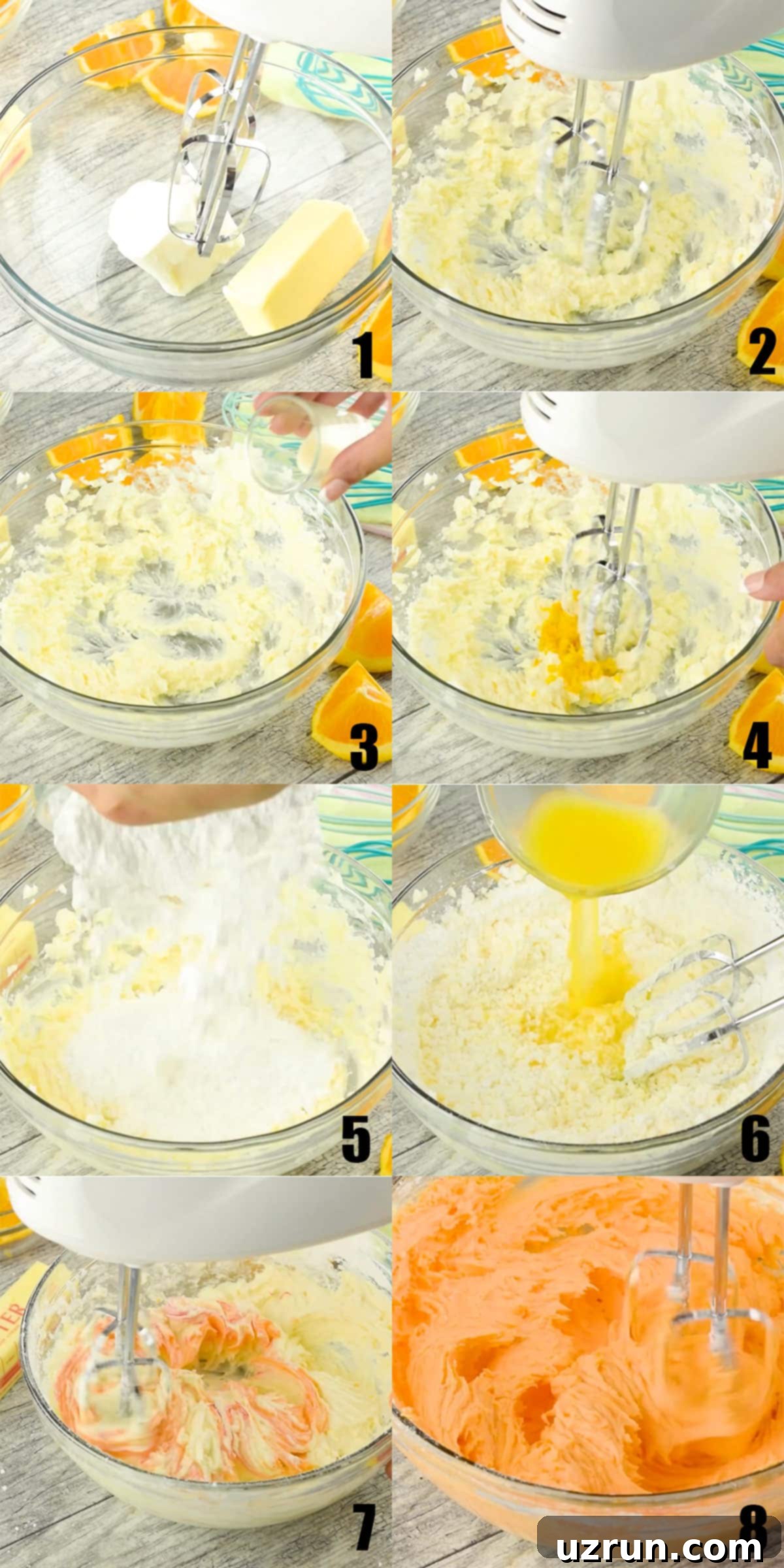
Expert Tips and Techniques for Flawless Orange Frosting
Achieving a bakery-quality orange frosting at home is easy when you know a few key tips and tricks. These techniques will help you create a perfectly smooth, stable, and flavorful buttercream every time:
- The Power of Butter and Shortening: To maximize the stability and ensure your icing holds its shape, especially in warmer climates, it’s highly recommended to use a combination of both butter and shortening. An “all butter” frosting can be prone to melting and softening, making intricate piping difficult. Shortening adds structure and a higher melting point, giving you a more resilient buttercream.
- Vibrant Color with Gel Food Coloring: For the best results, always use gel food coloring to enhance the orange color. Gel colors are concentrated and do not add excess liquid, which can thin out the frosting’s consistency. Avoid liquid food coloring, as its “watery” nature can easily disrupt the perfect balance of your buttercream.
- Adjusting Consistency – Too Thin: If your icing turns out too thin or runny, don’t fret! This usually means you’ve added too much liquid or not enough powdered sugar. The easy fix is to simply add more powdered sugar, a tablespoon at a time, mixing well after each addition until the desired thick and pipeable consistency is achieved.
- Adjusting Consistency – Too Thick: Conversely, if your orange frosting is too thick and stiff, it needs a little more liquid. Gradually add more orange juice or even a tiny bit of water, a teaspoon at a time, mixing until it reaches a smooth, spreadable, or pipeable consistency.
- Always Sift Powdered Sugar: This is a crucial step for a silky-smooth frosting. Powdered sugar often contains tiny lumps that can create an undesirable grainy texture in your buttercream. Sifting ensures a uniform, lump-free base for a truly professional finish.
- Room Temperature Ingredients are a Must: Ensure that both your butter and shortening are at true room temperature. This is vital for thorough and even mixing. Cold butter will not cream properly, leading to a lumpy and inconsistent frosting.
- Opt for Unsalted Butter: Using unsalted butter gives you complete control over the flavor profile of your frosting. You can then add a tiny pinch of salt if desired to balance the sweetness, preventing the frosting from becoming overly salty.
- Butter Over Margarine for Flavor: While margarine can be used as a substitute, butter offers a superior flavor and a richer, creamier consistency. For the best-tasting orange frosting, stick with real butter.
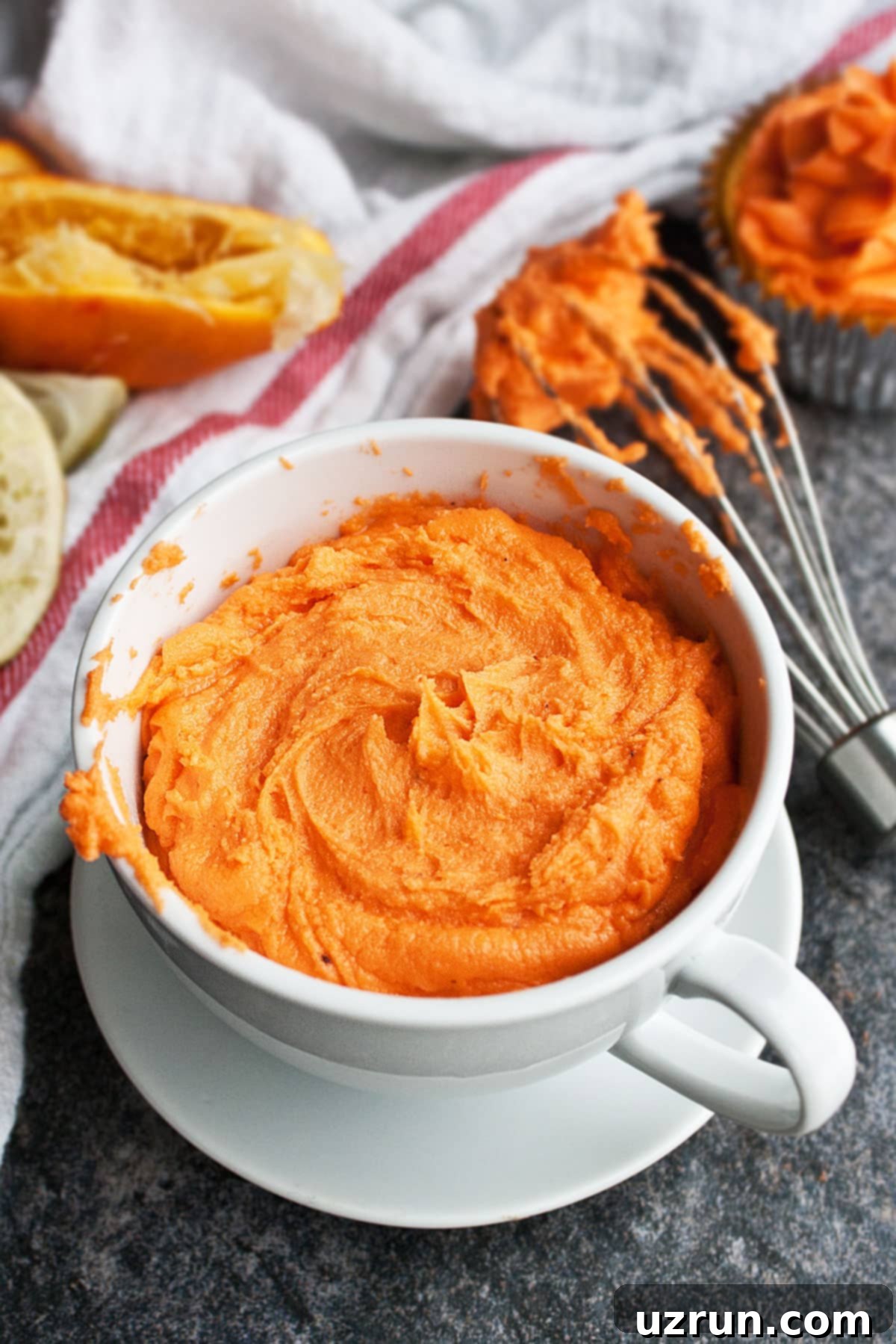
Recipe FAQs: All Your Orange Frosting Questions Answered
Have questions about your homemade orange frosting? We’ve got you covered with answers to common issues and concerns:
Your icing might be runny if you’ve added too much orange juice or haven’t incorporated enough powdered sugar. The good news is, it’s an easy fix! Simply add more sifted powdered sugar, a little at a time (about a tablespoon), while mixing. Continue until you achieve your desired thicker, more stable consistency.
If your frosting is too thick, it typically means you’ve used too much powdered sugar or not enough liquid. To correct this, gradually add a small amount of orange juice or water, about a teaspoon at a time, mixing thoroughly after each addition. Continue until the frosting reaches a smooth, spreadable, or pipeable consistency.
For vibrant and consistent color without altering the frosting’s texture, always use gel food coloring. Unlike liquid food coloring, gel colors are highly concentrated and won’t make your frosting runny. Start with a tiny amount and add more as needed, mixing thoroughly until you achieve your desired shade of orange.
Storage Tips for Orange Buttercream
Proper storage ensures your homemade orange frosting stays fresh and delicious for future use. Here’s how to store it:
- Room Temperature: If your kitchen isn’t excessively warm, this frosting can be stored in a sealed airtight container on the countertop for 2-3 days.
- Refrigerate: For longer storage, transfer the orange frosting to an airtight container and keep it in the fridge for up to 1 week. When ready to use, let it come to room temperature and then re-whip it for a minute or two to restore its fluffy texture.
- Freeze: This buttercream freezes beautifully! Place it in a freezer-safe, airtight container for up to 1 month. To use, thaw it in the refrigerator overnight, then let it sit at room temperature for about an hour before re-whipping until smooth and fluffy.
- Make Ahead: This is an excellent make-ahead recipe. Prepare the frosting completely, then store it in a sealed container in the fridge for up to 1 week, or in the freezer for up to 1 month. Thaw in the fridge, bring to room temperature, give it a quick mix, and it’s ready to use as needed!
More Orange and Citrus Desserts to Love
If you love the bright, zesty flavor of orange, then you’ll adore these other citrus-infused recipes:
- Orange Fruit Salad
- Chocolate Orange Brownies
- Orange Cupcakes
- Candied Orange Peel and Slices
- Orange Cranberry Bread
Recipe Card
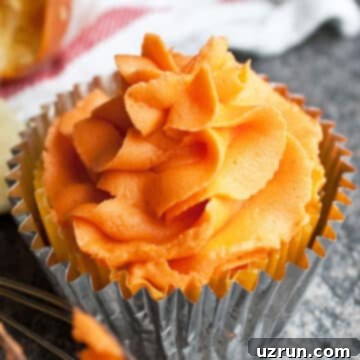
Easy Orange Frosting (Buttercream Icing)
Abeer Rizvi
Pin Recipe
Want to Save This Recipe?
Enter your email & I’ll send it to your inbox. Plus, get great new recipes from me every week!
By submitting this form, you consent to receive emails from CakeWhiz
Ingredients
- ⅓ cup Butter Unsalted, Room temperature
- ½ cup Shortening
- 2 tablespoon Orange zest
- 1 teaspoon Orange extract Or orange emulsion oil
- 4 cups Powdered sugar Preferably sifted
- ¼ cup Orange juice Freshly squeezed is best
- Orange gel coloring
Instructions
-
Cream together the room temperature butter and shortening in a large mixing bowl until light and fluffy.
-
Add orange extract and fresh orange zest, mixing again until well combined and fragrant.
-
Gradually add the sifted powdered sugar (1 cup at a time), alternating with splashes of orange juice. Mix on low until incorporated, then increase speed to medium-high and continue mixing until the frosting becomes wonderfully light and fluffy.
-
Finally, mix in a few drops of orange gel food coloring until your desired vibrant shade is achieved and evenly distributed. Enjoy your homemade orange buttercream!
Video
Notes
- For optimal stability and a frosting that holds its shape well, especially in warmer temperatures, use both butter and shortening.
- If you have access to orange emulsion oil, consider using it over extract. Emulsions offer a stronger, more concentrated orange flavor without adding much liquid.
- Always use gel food coloring instead of liquid food coloring. Gel colors are concentrated and won’t thin out the consistency of your buttercream.
- Leftover orange frosting can be stored in a sealed airtight container in the refrigerator for up to 1 week. Bring to room temperature and re-whip before use.
- This recipe yields enough frosting to beautifully fill and frost one 8×2 inch cake or pipe generous swirls on 24 standard cupcakes.
- For more detailed advice on troubleshooting and additional variations, be sure to read the comprehensive tips and variations sections above.
Nutrition
An automated tool is used to calculate the nutritional information. As such, I cannot guarantee the accuracy of the nutritional information provided for any recipe on this site.
